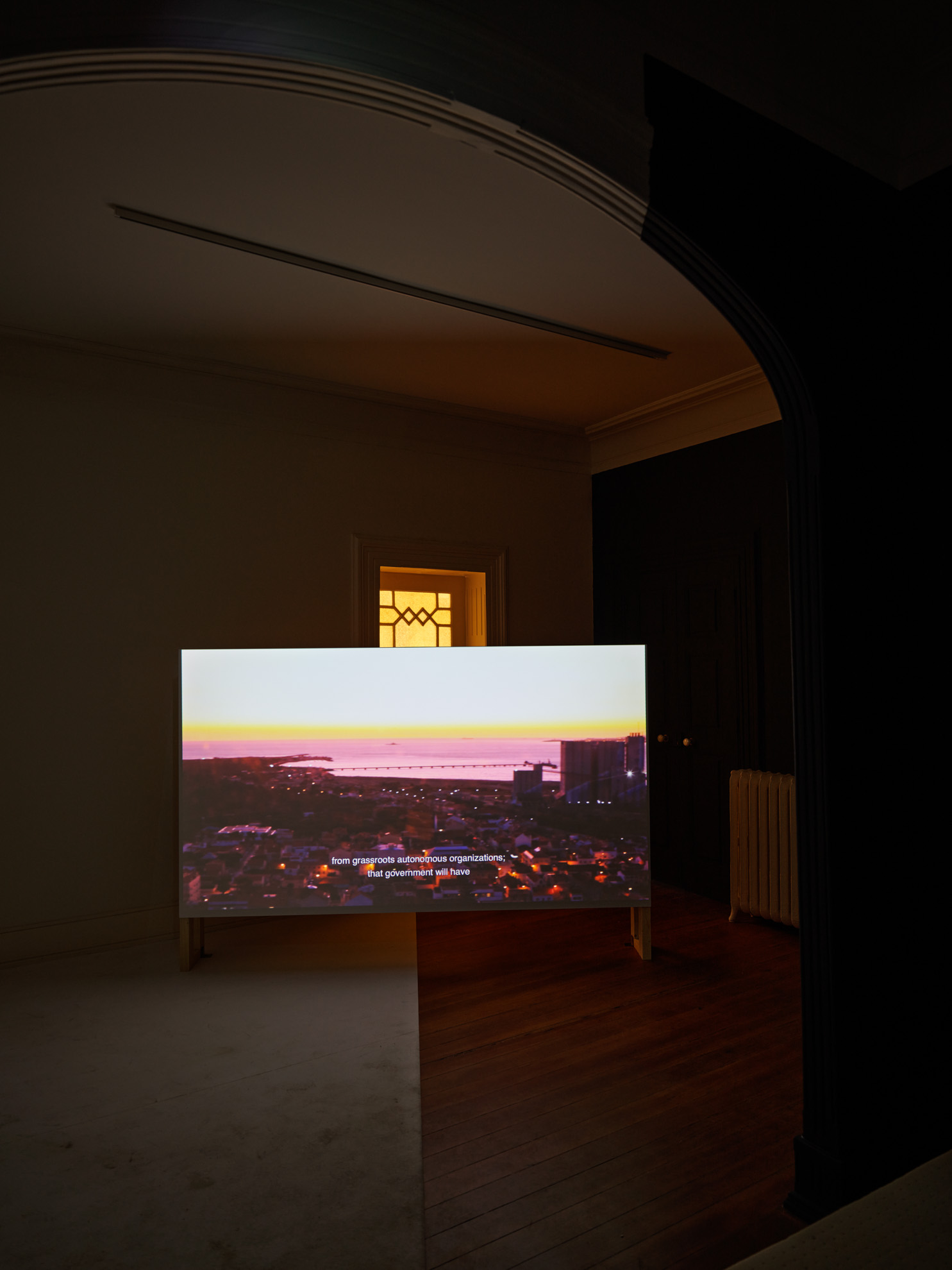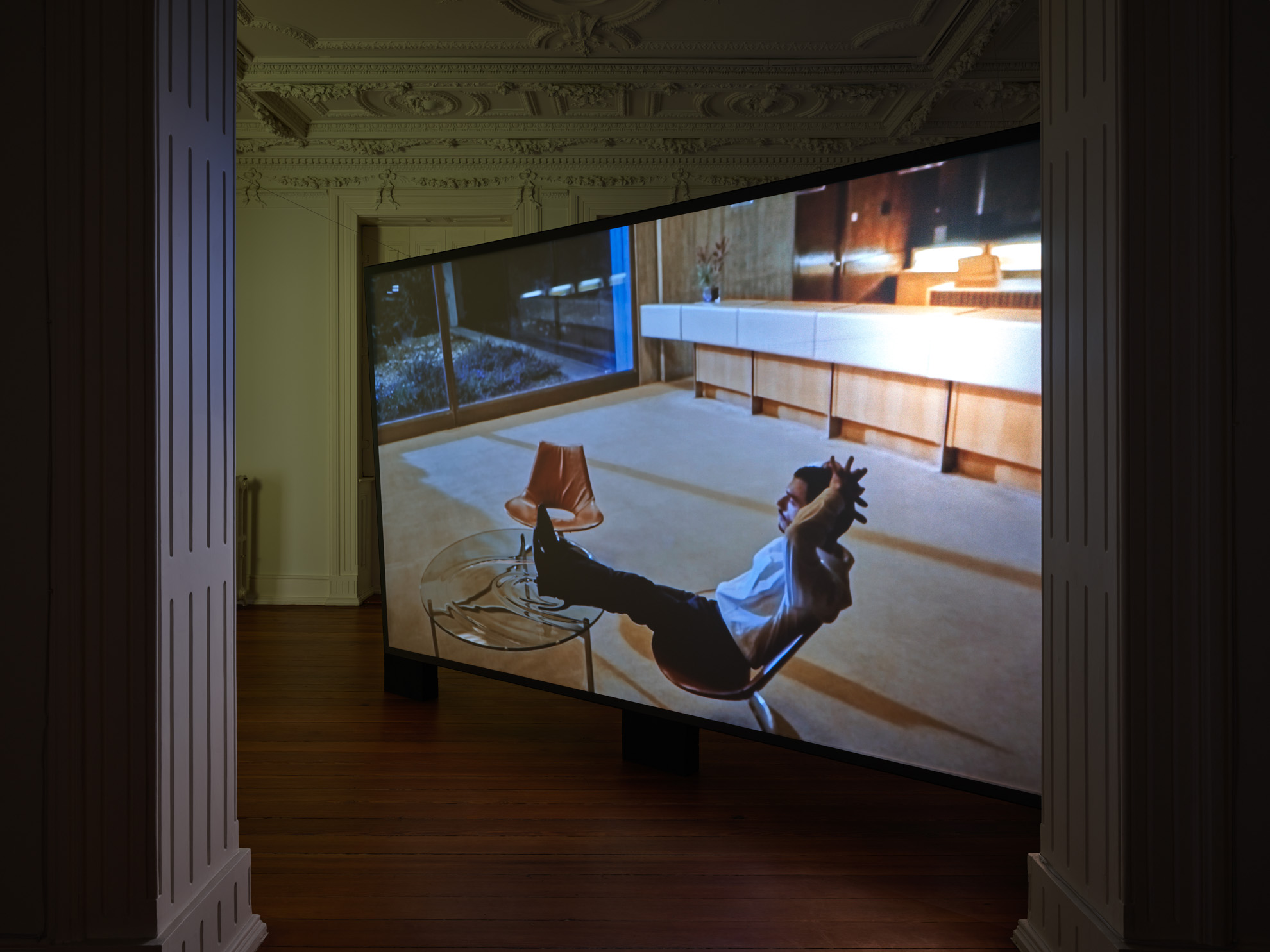Emily Wardill: Acrónica e à solta

Having just inaugurated a new project at the Kunst-Werke Berlin (Identical, 10 June to 20 August), the work of British artist and filmmaker Emily Wardill is being presented all summer in Hourless and at large, an exhibition at the crossroads of the experimental and retrospective formats which acts as a clarification with regard to a complex and polymorphic body of work.
Wardill has made a name for herself through her project installations and films, three of which are currently being shown at Casa São Roque: Game Keepers Without Game (2009), which won the Jarman Award in 2010, I Gave My Love a Cherry that Had No Stone (2016), and Night for Day (2020). Like many of her latest works, her films draw aesthetic inspiration from "expanded cinema"—a term that was coined in the mid 1960s to describe films that pushed the boundaries of cinema and the conventions of spectatorship—while engaging with imaginary layers of meaning.
With Hourless and at large, her second solo exhibition in Porto, the artist leads us into her way of fracturing narratives by also using here the exhibition context. Emily Wardill shares her concerns on how reality appears authentic to us. She is particularly interested here in the relationship between this imaginary world and the material one. To do this, the exhibition deploys a body of work meticulously selected from the last fourteen years until the present day. It is a unique immersion in the work of an artist whose practice extends from film to photographic works, drawings, objects proper etc., and who has never ceased to investigate the complexities of representation and its limitations.
Bringing together a large body of works that include the three previously mentioned films, the exhibition is an introspection into a particular selection where we find some props taken from her films (a pair of customised shoes, a painting, modern furniture etc.) that are figures of acting as well as status symbols, evidence of crime and fictitious remains. This selection is displayed with other artworks by the artist which lead to a confusion about what is to be seen.
Admirably orchestrated in collaboration with the curator Barbara Piwowarska, the space of the Casa São Roque becomes one of potential fictions, while reminding us of its context as the exhibition space of an old villa that is structurally linked to many previous presentations of the artist’s work. Hourless and at large in no way denigrates what preceded it. If her works Night for Day (shown at Bassness, Rialto6, Lisbon, 11 February to 29 April 2022) and I Gave My Love a Cherry that Had No Stone (produced for Mat Black and Rat, Calouste Gulbenkian Foundation, Lisbon, 2 to 28 June 2017) were shown in Lisbon and elsewhere, their reunion at distance from the capital is a first in Portugal. Based on staging and psychologically charged space, this is an opportunity to experience particular forms of interaction as well where the exhibition generates connections that defy the spatiotemporal condition of the site-specific experience.
Here, the artist has chosen to maintain a specific dialogue with the space of the Casa São Roque and its history. In this bourgeois house built in 1759, the interior of which has changed over time and according to the tastes of its occupants, the exhibition route opens onto the former dining room. There, a light and sound installation entitled Sleep Patterns and Musical Chairs (2023), which the artist specially produced for the occasion, is revealed in a nineteenth-century-style room, modelled on French historicism, which is itself inspired by past and ancient glories.
It is in relation to this weighty conservatism that Emily Wardill immerses us in a sensitive experience that contrasts with the interior architecture and its solemn decor: Sleep Patterns and Musical Chairs gracefully contrasts with the sense of paternalist superiority that dominates in this space to lead us into an atmosphere of distorted music played on the piano (by Daniel Bernardes). Here, one can just barely recognise dissonant national anthems. Rays of light sweep across the ceiling, as if projected by the headlights of a car from the road below. A scene seems to come alive. This room, designed to function in series that run from daylight to chiaroscuro, favourably lends itself to the cinematographic metaphor. The architecture plays the role of materialising a sequence shot from which a fiction, in the form of an escape, emerges as an alternative to the ambient imperialism, which is coupled with a chilling romanticism.

Continuing the visit, the three films are screened on the same ground floor of the house. Separated by rooms, the visitor can move easily from one environment to another. We then understand that, by its very structure, the route of the exhibition opens itself up to the narrative of the films. Devised as a logical and sensitive follow-up to previous occurrences, this new exhibition operates forms of overlapping and mise-en-abyme that are suggested by some of the spaces shown in certain scenes in the films. Through their proximity, the images contaminate each other and continue to expand their cinema.
I Gave My Love a Cherry that Had No Stone and Night for Day are two major film works that Emily Wardill made in Portugal. The first was shot in the foyer of the Grand Auditorium at the Calouste Gulbenkian Foundation. By following the progression of a dancer, it explores the performative relationship between body and space and their mutual contamination. Through both the construction of the film and the way it is presented—the screen is leaning and hanging in a wobbly fashion—it destabilises the position of the viewer.
The second film is based on a fake mother-and-son relationship that imagines what would happen if a communist utopian, in the form of Isabel do Carmo who was a revolutionary resistance fighter against the fascist regime in Portugal, gave birth to a techno utopian. In this case, the large screen is installed in front of a bulky seat made of two distinct materials. The seat seems to be made to be looked at rather than really being sat on.
The film Game Keepers Without Game translates the seventeenth-century play by Calderón de la Barca into a contemporary British context. It tells the story of a girl put up for adoption by her family at a young age and traces her difficult return after being banished from the family home. The work is installed in front of a bench in a classic and frontal way, as if to follow the immersive genealogy that the artist wanted to make us experience.
Emily Wardill is one of those artists who puts processes of deconstruction to work, who forges stories from structural content in particular, and who questions reality and its modes of fabrication. Hourless and at large does not simply offer itself up as something to watch—as one more opportunity to reach an ever-larger audience; it questions its relationship to the visible and places the visitor at the heart of the reception process.
The rest of the exhibition is made up of installations and objects hung in a subtle mix of genres: put on the same level, the artworks mentioned previously are displayed with props from the film. Throughout the meticulous hanging, their titles display as much variety as the forms that oscillate between the created and the readymade works, thus participating in a deliberately orchestrated confusion concerning the status of the elements shown. Artistic or not, only the testimony of an appearance in the film attests to its status, especially since the illusion is evoked through props that are copies of artworks, such as a reproduced painting by Cuban artist Wifredo Lam—although not done quite identically as it seems to have been vandalised—and hung at the foot of a staircase as though it were part of the original decor of Casa São Roque.
From the ground to the second floor of the house, many artworks appear, sometimes as if they were part of the decor or as if they were like ghosts from the past. As an example, Through the walls (2016), a series of relief sculptures that are in fact folded shirts that merge into the stucco. Each one is titled after the names given to origami sculptures. But the motif of the shirt is also present in one of the films, multiplying again the reading in the interplay of all senses and their boundaries.
Estelle Nabeyrat is a curator and an art critic (AICA member) living between France & Spain, currently teaching at ENS-Paris-Saclay design dept. She lately curated Langages tissés, Isabel Carvalho at Centre d’art Le Lait, Albi, Falso sol, Falsos Olhos, Elisa Pône at Galerias municipais Lisboa. With Pedro De Llano, she was recently heading a research on artists in exile (Latin America & Caribbean) for the Cnap, French National Collection in Paris. She is the co-organizer with artist Eva Barto of ForTune, program on artists workers conditions on DUUU* webradio. She writes regularly for Le Quotidien de l’art (fr), Camera austria (aut), Texte zur Kunst (de).
Proofreading: Diogo Montenegro.

Emily Wardill, Hourless and at large. Exhibition views at Casa São Roque, Porto, 2023. Photos: Filipe Braga. Courtesy of the artist and Casa São Roque Centro de Arte.




